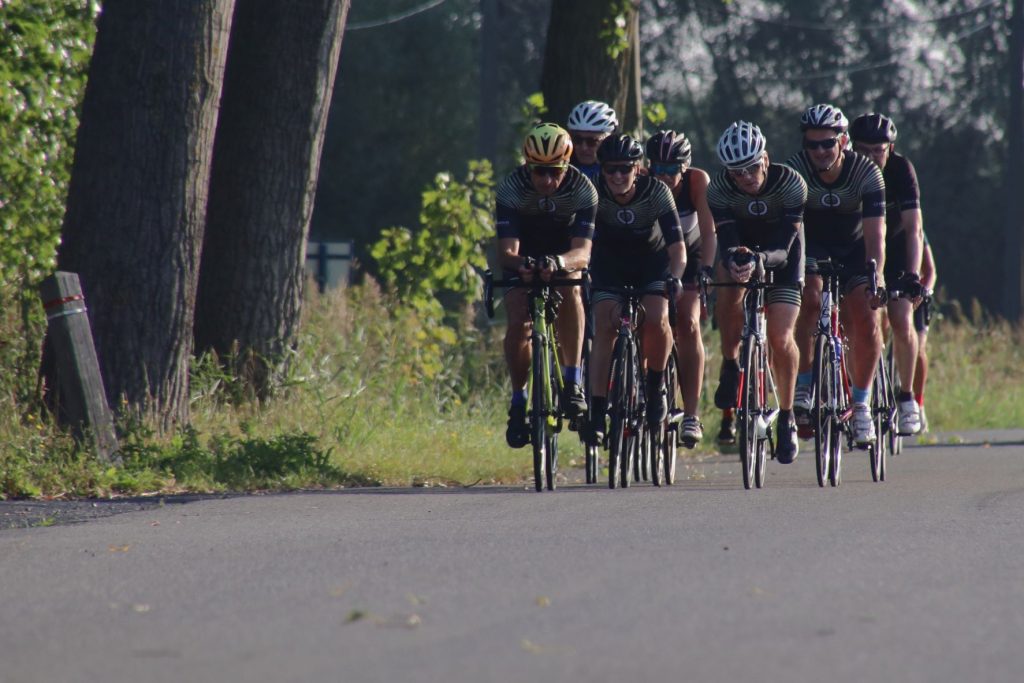Training In A Group vs Training Solo
We probably don’t need to tell you that Triathlon has the potential to be quite an isolating sport. Hours of training away from friends and family can not only be mentally challenging but also have a negative impact on relationships too. So it makes sense that you might want to mix things up and go for a group ride or run with friends from time to time. But what are the pros and cons of group vs solo training? Here our head coach Kevin gives his thoughts:
“I’m a great believer in taking a hybrid approach when it comes to making a decision to train solo or in a group. It obviously depends on a lot of factors such as the experience of and goals of the athlete compared to that of the group they choose to train with. The main takeaway I try to impart on the athletes I work with is that too much of anything is a bad thing, try and strike a balance between the two that work for you.
Group Training
When it comes to training in a group there are some undeniable benefits. Starting with the obvious, it’s great to socialise with different people. Whether you’re a naturally sociable person or not, training in a group or club is a good way to make like-minded friends. From moral support at races to having a group to ‘talk shop’ with, these benefits can’t be understated. A happy athlete is often an athlete that performs well.
These mental benefits aren’t just limited to making friends though. If you’re surrounded by a positive group the encouragement you receive from them can really help motivate you to achieve your goals. It’s also an extra level of accountability, you’re much less likely to skip out that cold morning run if you know you’ll be letting down your training partner if you don’t show up.

It’s almost inevitable that when you spend time training with others it will lead to some healthy competition, as long as it doesn’t get out of hand this can allow you to push harder than you may have done alone. Likewise, other people bring variety that can keep your training fresh and offer new training stimuli you may not have targeted before. Also if you’re training as part of a club there will often be coaches that can point out areas for you to improve upon or new techniques to try.
Another important benefit to training together is safety. This is especially important when it comes to open water swimming, you should never swim in open water on your own as even the strongest swimmers can get caught out. Even with running and cycling you’ll be safer in a group, especially if you are training through dark winter nights and mornings.

It’s not all positive though, there are certainly some drawbacks to training with others. Peer pressure can definitely come into play when in a group. This often plays out as ignoring the little twinges and pains that might be indicative of overtraining or upcoming injuries. With the risk of overdoing it so high it’s crucial you don’t ignore these signs from your body.
When there’s a group of you training together the chances are that your varying fitness levels and training plans mean someone is going to be training outside of what their coach (or training plan) might have intended them to do. One of the keys to triathlon success is consistency so this isn’t something you want to make a habit of. Sometimes it will be better to sit out a group session if it falls outside of what your plan dictates. This is where the previously healthy competition we mentioned before can become a problem. If you’re focusing on beating your training partners instead of the quality of your workout then the effectiveness of your training can be greatly reduced.
Training Solo
Training on your own can be beneficial in a number of ways. Ultimately it’s much easier to stick to your training plan if you’re not having to accommodate training partners or getting a draft when on a long ride. You can ride, run and swim at exactly the pace you need to and there’s no distractions to stop you from properly executing your workouts.
If you’ve got family or work commitments it’s much easier to mould your plan around your life if you’re flying solo as you can fit in workouts whenever the time is right. This extends to using home gym and training equipment; why drive miles to and from a group session when you can just hop on the turbo or run straight from the front door?
Perhaps the biggest pro to training alone is building the mental fortitude required to perform at races. If you have the mental strength to get out and train on your own every day regardless of what life throws in your way this will keep you in good stead if you ever find yourself in a tough place come race day.

The first negative to training alone is one I think we’ve all experienced, no matter how much we like training it’s unavoidable that some sessions can be boring! A long six hour ride for example can really drag. It’s easy to lose motivation if you’re constantly training alone so having someone of a similar level to chat to can really take the edge off and keep you interested in tackling those big sessions.
Another risk with training alone is stagnancy, especially if you’re writing your own training plan. Without outside input it’s easy to get stuck in a rut and not really push yourself to your limits. A coach will help with this but other people can also help you push through the pain to new heights. Think of it as peer pressure but in a good way! We also learn a lot from just watching and being around other athletes. Have you got a friend who’s a great descender on the bike? You can almost guarantee that after a few rides trying to keep up with them you’ll notice your skills increase. This doesn’t just apply to the bike, pay attention to how the top athletes you know swim and run. Try out their techniques when you train, you might be surprised at the outcome.”
Whether you prefer to train in a group or on your own, we will be able to tailor a training plan that helps you unlock your ultimate potential. Contact us today to find out more.